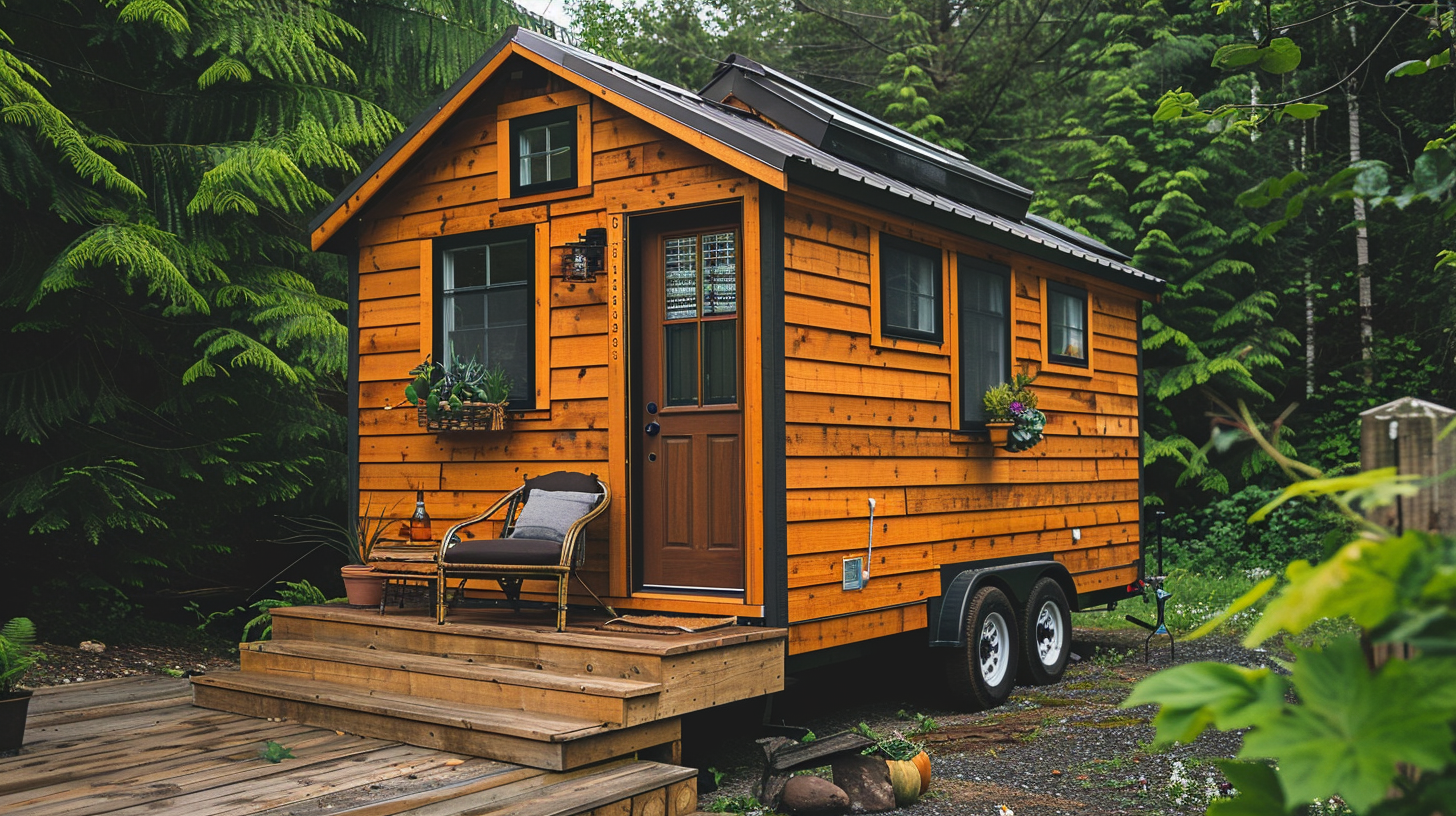Table of Contents Show
In the heart of a bustling city, we’ve seen a community of tiny houses emerge, challenging traditional views on home ownership. We’re intrigued by how these compact dwellings not only offer a solution to the housing crisis but also embody a commitment to sustainability and minimalism. They’re reshaping our understanding of what it means to possess a home in the 21st century. As we explore the origins, benefits, and challenges of the tiny house movement, we invite you to contemplate how these small spaces might inspire big changes in our lives and communities. What could this imply for the future of housing?
Key Takeaways
- The tiny house movement challenges traditional home ownership, emphasizing freedom, flexibility, and financial independence.
- It promotes sustainability and minimalism, reducing carbon footprint and encouraging a connection with nature.
- Innovative design and smart use of space allow for personalized, functional, and aesthetically pleasing homes.
- Legal and community challenges persist, but growing global interest and innovation signal a promising future for tiny living.
Origins of the Movement
The tiny house movement, often traced back to the early 2000s, fundamentally challenges traditional concepts of home ownership. We’ve seen a drastic shift in what it means to have a ‘home’. No longer does it hinge on the accumulation of space and stuff. Instead, we’re embracing freedom, flexibility, and financial independence. This seismic change didn’t just emerge out of the blue; it’s a response to the skyrocketing costs of living and a collective yearning for a simpler life.
We’re all too familiar with the burdens of hefty mortgages and the relentless pursuit of more. It’s a cycle that’s left many of us feeling trapped and disconnected from what truly matters. The pioneers of the tiny house movement weren’t just looking to downsize their physical space; they were seeking to upsize their lives. By breaking free from the shackles of conventional home ownership, they’ve opened up a world of possibilities where travel, adventure, and living on our own terms aren’t just dreams—they’re our new reality.
As we dive deeper into this movement, we’re finding that it’s not just about the houses themselves but the spirit they embody. It’s a declaration of independence from societal expectations and a step towards a more sustainable and intentional lifestyle. We’re not just changing where we live; we’re redefining how we live. And in this journey, we’re discovering that sometimes, the smallest spaces lead to the biggest freedoms.
Environmental Benefits
We’re now turning our attention to the environmental benefits that the tiny house movement brings to the table. By embracing smaller living spaces, we greatly reduce our carbon footprint and minimize resource consumption. Additionally, tiny houses often incorporate green practices that support enhanced biodiversity, making them a boon for the environment.
Reduced Carbon Footprint
In recent years, embracing the tiny house movement has greatly reduced our collective carbon footprint, spotlighting a greener path in home ownership. By downsizing, we’re not just freeing ourselves from the chains of hefty mortgages and endless clutter; we’re also making a significant stride towards a more sustainable future. Smaller living spaces mean we’re demanding less from our planet, contributing to a reduction in greenhouse gas emissions. It’s a lifestyle choice that reflects our commitment to preserving the environment for future generations while enjoying the freedom that comes with simplicity. Adopting tiny houses isn’t just a trend; it’s a conscious decision to live lightly on the earth, proving that less really can be more.
Minimal Resource Consumption
Building on the environmental strides made by reducing our carbon footprint, adopting tiny houses also leads to minimal resource consumption. By embracing smaller living spaces, we’re not just cutting down on energy use; we’re fundamentally changing how much we consume. Tiny houses require fewer materials for construction and less energy to heat and cool, greatly reducing our demand on natural resources. This shift isn’t just about saving the planet; it’s about reclaiming our freedom. Freedom from excessive bills, freedom from clutter, and the freedom to live sustainably without sacrificing comfort or style. We’re pioneering a way of life that values quality over quantity, proving that living more with less isn’t just possible—it’s liberating.
Enhanced Biodiversity Support
Adopting tiny houses not only minimizes our ecological footprint but also greatly bolsters local biodiversity. By taking up less space, we leave more room for nature to thrive. It’s about giving back to the earth, allowing plants and wildlife to flourish right at our doorsteps. We’re creating habitats, not just homes. This shift supports ecosystems, promoting a variety of plant and animal life. It’s a step towards coexisting with our environment, rather than dominating it. We’re not just seeking freedom for ourselves; we’re granting it to the natural world around us. Tiny living isn’t just a personal choice; it’s a communal contribution to a healthier planet. By choosing less, we’re actually offering more to the world’s biodiversity.
Financial Advantages
Turning our attention to the financial benefits, it’s clear that the Tiny House Movement offers significant savings. Reduced maintenance costs and the savings from minimalist living directly impact our wallets in a positive way. Let’s explore how these aspects can redefine what we consider necessary in home ownership.
Reduced Maintenance Costs
One of the most compelling financial advantages of the tiny house movement is the significant reduction in maintenance costs we observe. Living in a smaller space means:
- Less area to clean, so we’re spending less time and money on cleaning supplies.
- Fewer appliances and systems to repair, cutting down on unexpected expenses.
- Lower utility bills, as heating and cooling a tiny house costs a fraction of a traditional home.
- Reduced wear and tear, since there’s simply less house to maintain over time.
These savings directly translate into more freedom for us. We’re not just saving money; we’re buying back our time and the flexibility to live on our own terms. The tiny house movement isn’t just about downsizing our space—it’s about upsizing our lives.
Minimalist Living Savings
Beyond the reduced maintenance costs, embracing minimalist living within the tiny house movement amplifies our financial savings considerably. We’re not just cutting back on square footage; we’re redefining what’s essential. This mindset shift means we spend less on furniture, decorations, and, importantly, on things we don’t truly need. It’s not merely about saving a few dollars here and there. It’s about freeing ourselves from the endless cycle of consumption and clutter. By investing in quality over quantity, we’re not only saving money but also creating a space that reflects our most cherished values. This approach extends beyond our homes, influencing our choices in fashion, food, and travel, further boosting our savings. We’re not just saving money; we’re crafting a lifestyle that prioritizes freedom and financial independence.
Design and Innovation
In the domain of the tiny house movement, innovative design plays a pivotal role in reimagining what makes a home both functional and appealing. We’re not just shrinking standard homes; we’re revolutionizing the concept of living spaces. Our creativity and innovation pave the way for a lifestyle that champions freedom and flexibility, without sacrificing comfort and aesthetics. Here’s how we’re doing it:
-
Maximizing Space: Every square inch counts. We’ve become masters at creating multi-functional furniture and built-ins. Tables fold away, beds retract into walls, and storage is hidden ingeniously throughout our tiny homes. It’s all about making the most of what we have.
-
Sustainable Materials: We’re not just thinking about size, but also about the impact on the planet. Incorporating reclaimed wood, solar panels, and rainwater collection systems, we’re building homes that are as kind to the earth as they are to our spirits of adventure.
-
Customization: Our homes reflect our unique personalities and needs. Whether it’s a home office that doubles as a yoga studio or a kitchen designed for a gourmet chef, we’re proving that tiny doesn’t mean one-size-fits-all. It’s about creating a space that feels like it’s truly ours.
-
Tech Integration: We’re embracing technology to make our tiny homes smarter. From remote-controlled heating and cooling systems to compact appliances that work harder and smarter, we’re ensuring that our homes are efficient and ready for the future.
As we push the boundaries of design and innovation, we’re not just building houses; we’re crafting the keys to a lifestyle that embodies freedom, sustainability, and personal expression.
Lifestyle and Minimalism
Having explored how innovation shapes our tiny homes, let’s now examine how this lifestyle embraces minimalism and simplicity. We’re drawn to tiny living because it strips away the excess, focusing on what truly matters. It’s not just about having fewer possessions; it’s about creating more space in our lives for freedom and experiences.
We’ve discovered that minimalism isn’t about sacrifice, but rather, making room for more of what gives us joy. In our tiny homes, every item serves a purpose, and there’s a profound sense of satisfaction in that simplicity. We’re not bogged down by clutter or the maintenance of unnecessary belongings. Instead, we invest our time and resources in what truly enriches our lives.
This lifestyle has taught us the value of quality over quantity. We choose items that not only fit our space but also our values, opting for sustainability and durability. It’s a conscious choice to live more with less, reducing our environmental footprint while enhancing our personal freedom.
Minimalism in a tiny home goes beyond physical possessions; it’s a mindset that permeates every aspect of our lives. We’ve embraced a less is more philosophy, finding that a simplified life leads to greater happiness and fulfillment. It’s a liberating experience, freeing us from the conventional expectations of success and allowing us to define our own paths.
As we journey through tiny living, we’re continually reminded of the power of minimalism to transform our lives. It’s not just about the space we occupy but the space we create for ourselves to live freely and authentically.
Community and Connection
As we explore the tiny house movement further, we recognize that it’s not just about downsizing our physical space, but also about creating stronger community ties. By building shared spaces, we’re fostering environments where social bonds can flourish. This aspect underscores the movement’s potential to redefine not only our living spaces but how we connect with those around us.
Building Shared Spaces
We’re crafting communal areas that foster connection and a sense of belonging within the tiny house community. These shared spaces are essential for those of us seeking freedom without sacrificing the joys of community. Here’s how we’re making it happen:
- Community Gardens: We’re planting seeds, both literally and figuratively, nurturing growth and togetherness.
- Outdoor Kitchens: We’re cooking up not just meals, but memories, sharing recipes and stories under the open sky.
- Workshop Areas: We’re building dreams together, from crafting furniture to tinkering with sustainable tech.
- Common Rooms: We’re creating cozy spaces for meetings, movie nights, or just a quiet afternoon with a book.
These shared spaces are the heart of our community, where we come together, celebrating our choice for a simpler, yet richer life.
Fostering Social Bonds
Building a vibrant community involves more than just shared spaces; it’s about fostering deep, meaningful connections among residents. We’re not just neighbors; we’re a tight-knit family, choosing to live in a way that brings us closer to what truly matters. In our tiny house community, we share more than walls; we share experiences, laughter, and support. We’ve discovered freedom in simplicity, and in doing so, we’ve opened up a richer, more connected way of life.
| Emotion | Connection | Freedom |
|---|---|---|
| Joy | Laughter | Choice |
| Support | Conversations | Simplicity |
| Growth | Shared meals | Exploration |
| Unity | Assistance | Independence |
Legal Considerations
Exploring the legal landscape is important for tiny house enthusiasts seeking to legitimize their alternative living spaces. We’re all about embracing freedom and the tiny house movement embodies that spirit. However, maneuvering the legalities can be a bit like walking through a maze. Here’s what we need to take into account:
-
Zoning Laws: Many areas have strict zoning laws that can restrict where tiny houses can be placed. It’s important to research local zoning regulations to find out where it’s permitted to park or build your tiny house. Some areas are more welcoming, offering specific zones for tiny living.
-
Building Codes: These are the rules that dictate how a structure must be built. For a tiny house on wheels (THOW), the building codes might be different than for those set on a foundation. We must make sure our tiny homes meet these standards to ensure safety and compliance.
-
RV Classification: If your tiny house is on wheels, it might be classified as a recreational vehicle (RV). This classification affects where you can legally park and live in your tiny house. RV parks are an option, but long-term living in these parks often hinges on local regulations.
-
Property Taxes: Tiny houses on foundations might be subject to property taxes, similar to traditional homes. However, the tax implications can vary significantly based on location and the home’s classification. Understanding these potential costs upfront can help us budget more effectively.
Maneuvering these legal considerations is a step towards securing our freedom to live as we choose. It’s about finding balance within the system, making sure our tiny homes are both a place of refuge and a sign of our autonomy.
Challenges and Solutions
Exploring the challenges of the tiny house movement, we’ve identified practical solutions to common obstacles faced by homeowners. We’ve realized that one major hurdle is finding the right location. Many of us dream of a life unbound by traditional housing constraints, yet zoning laws and land use regulations often stand in our way. We’ve found that networking within tiny house communities can lead to shared insights about friendly areas, and some of us have even collaborated to purchase land together, creating our own tiny house enclaves.
Another challenge lies in maximizing the small space without feeling cramped. To conquer this, we’ve embraced multi-functional furniture and innovative storage solutions that allow us to live comfortably and clutter-free. Custom-built pieces that serve multiple purposes, from beds with built-in storage to foldable workspaces, have become our best friends.
We’ve also faced hurdles with obtaining financing and insurance. Mainstream financial institutions often don’t know how to classify tiny houses, making loans difficult to secure. To navigate this, we’ve looked towards alternative financing options, such as personal loans or crowdfunding. For insurance, we’ve learned that shopping around and being transparent about our needs can lead to providers willing to create custom policies for our unique homes.
Finally, utility connections can be tricky, but we’ve found freedom in off-grid living solutions. Solar panels, composting toilets, and rainwater collection systems not only solve our utility issues but also further our commitment to a sustainable lifestyle.
In facing these challenges head-on, we’re not just finding solutions; we’re paving the way for a lifestyle that embodies true freedom and self-reliance.
Global Perspectives
Across the globe, we’re witnessing an incredible diversity in how different cultures embrace and adapt the tiny house movement to meet their unique needs and lifestyles. This movement isn’t just about downsizing physical space; it’s a profound shift towards freedom, sustainability, and community that resonates worldwide. Let’s explore how various regions are making the tiny house movement their own:
-
In North America, we’re seeing a surge in tiny house communities that foster a sense of belonging and shared values. People are drawn to the idea of living more with less, finding that smaller spaces lead to bigger lives filled with meaningful connections.
-
Europe’s approach often blends historical charm with modern minimalism, repurposing old structures like shipping containers and barns into stylish and efficient tiny homes. This not only preserves cultural heritage but also promotes a more sustainable way of living.
-
In Asia, particularly in densely populated countries like Japan, the tiny house movement aligns perfectly with traditional values of simplicity and harmony with nature. Here, tiny houses are designed with ingenious compactness and efficiency, serving as a proof to the art of maximizing small spaces.
-
Australia and New Zealand are pioneering in their use of off-grid tiny homes, empowering individuals to live independently and in closer connection with the natural world. This reflects a growing desire for autonomy and a life untethered from conventional expectations.
We’re all united in our quest for freedom and a meaningful existence. The tiny house movement shows us that, regardless of where we are in the world, we can redefine what home means to us, fostering a global community of like-minded individuals who value simplicity, sustainability, and connection.
Future Directions
Having observed how the tiny house movement has uniquely unfolded in different parts of the world, let’s now consider where it may head in the future. This movement isn’t just a fleeting trend; it’s a powerful expression of our collective desire for freedom, sustainability, and financial independence. As we look ahead, we’re convinced that tiny living will not only persist but flourish, driven by our shared yearning to break free from traditional constraints and embrace a life of simplicity and purpose.
We’ll likely see a surge in innovative designs that push the boundaries of what a tiny home can be. These homes won’t just be small; they’ll be smart, utilizing cutting-edge technology to maximize space and efficiency. We’re talking about collapsible walls, multi-functional furniture, and energy systems that let us live off-grid more comfortably than ever before.
Community living is another exciting frontier. Imagine tiny house villages where we share resources, from communal gardens to workshop spaces, fostering a sense of connection and mutual support that’s often missing in today’s world. This isn’t just about downsizing our physical space; it’s about upsizing our lives in ways that truly matter.
And let’s not forget the potential for policy changes. As more of us demand the right to live tiny, we expect to see local governments adapting zoning laws to accommodate this lifestyle. This would not only legitimize our choice but also pave the way for a broader acceptance and integration of tiny living into the mainstream.
In a world that’s constantly changing, we’re choosing to steer our future towards freedom, creativity, and community. The tiny house movement is just the beginning.
Conclusion
In wrapping up, we’ve journeyed together like modern-day Thoreaus, seeking simplicity and sustainability in our own Walden—albeit on wheels or foundations. The tiny house movement isn’t just about downsizing physical space; it’s about upsizing life quality. Despite legal hurdles and societal skepticism, we’re crafting innovative, eco-friendly homes and redefining what it means to live well. As we look ahead, let’s continue to challenge norms, embrace minimalism, and build a future where less truly is more.








